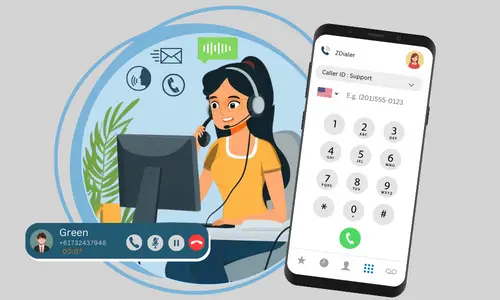SIP responses
SIP responses are codes used in the Session Initiation Protocol for communication. They indicate the status or outcome of a SIP request. Here is a list of SIP responses along with their corresponding codes and brief descriptions:

1xx Informational responses:

- 100 Trying: Indicates that the request has been received and the server is processing it.
- 180 Ringing: Notifies the calling party that the destination is ringing or being alerted.
- 181 Call Is Being Forwarded: Informs that the call is being forwarded to another destination.
- 182 Queued: Indicates that the destination is temporarily unavailable, and the call has been queued.
- 183 Session Progress: Provides additional information about the progress of the call setup.
- 199 Early Dialog Terminated: Indicates that an early dialogue has been terminated.
2xx Success responses:
- 200 OK: Indicates that the request was successful.
- 202 Accepted: Informs that the request has been accepted for processing, often used for referrals.
- 204 No Notification: Indicates a successful request, but no response will be received.


3xx Redirection responses:
- 300 Multiple Choices: Indicates that there are multiple options available, and the user or client should choose one.
- 301 Moved Permanently: Informs that the requested address has permanently moved, and provides the new address.
- 302 Moved Temporarily: Indicates a temporary move to a different address, and the client should try again.
- 305 Use Proxy: Specifies that the request should be redirected through the proxy specified in the Contact header.
4xx Request failure responses:
- 400 Bad Request: Indicates that the request has malformed syntax and cannot be understood.
- 401 Unauthorized: Requires user authentication for the request. Typically issued by user agents and registrars.
- 402 Payment Required: Reserved for future use.
- 403 Forbidden: The server understood the request but refuses to fulfill it.
- 404 Not Found: Indicates that the requested user or resource does not exist.
- 405 Method Not Allowed: The method specified in the request is understood but not allowed.
- 406 Not Acceptable: The server cannot generate responses with acceptable content.
- 407 Proxy Authentication Required: Authentication is required by the proxy server.
- 408 Request Timeout: The server couldn’t find the user in time.
- 409 Conflict: Indicates that the user is already registered (deprecated).
- 410 Gone: The user existed in the past but is not available at the current location.
- 411 Length Required: The server requires a valid content length in the request (deprecated).
- 412 Conditional Request Failed: The given precondition for the request has not been met.
- 413 Request Entity Too Large: The request body is too large.
- 414 Request URI Too Long: The server refuses to service the request because the Request-URI is too long.
- 415 Unsupported Media Type: The request body is in a non-supported format.
- 416 Unsupported URI Scheme: The Request-URI is unknown to the server.
- 417 Unknown Resource-Priority: The request included a resource-priority option tag, but no Resource-Priority header.
- 420 Bad Extension: The request contains an unsupported SIP protocol extension.
- 421 Extension Required: The server requires a specific extension that is not listed in the Supported header.
- 422 Session Interval Too Small: The request contains a Session-Expires header with a duration below the minimum.
- 423 Interval Too Brief: The expiration time of the resource is too short.
- 424 Bad Location Information: The location content in the request is malformed or unsatisfactory.
- 428 Use Identity Header: The server policy requires an Identity header, which has not been provided.
- 429 Provide Referrer Identity: The server did not receive a valid Referred-By token in the request.
- 430 Flow Failed: A specific flow to a user agent has failed, while other flows may succeed.
- 433 Anonymity Disallowed: The request has been rejected because it was anonymous.
- 436 Bad Identity Info: The request contains an Identity-Info header with an unresolvable URI scheme.
- 437 Unsupported Certificate: The server could not validate a certificate for the domain that signed the request.
- 438 Invalid Identity Header: The server obtained a valid certificate for a request but couldn’t verify the signature.
- 439 First Hop Lacks Outbound Support: The first outbound proxy does not support the “outbound” feature.
- 440 Max-Breadth Exceeded: If a SIP proxy determines that a response context has insufficient Incoming Max-Breadth to carry out a desired parallel fork and cannot compensate, it returns a 440 response.
- 469 Bad Info Package: If a SIP UA receives an INFO request associated with an Info Package that it has not indicated willingness to receive, it must send a 469 response indicating the Info Packages it is willing to receive.
- 470 Consent Needed: The source of the request does not have the permission of the recipient to make such a request.
- 480 Temporarily Unavailable: The person being called is currently unavailable.
- 481 Call/Transaction Does Not Exist: The server received a request that does not match any ongoing call or transaction.
- 482 Loop Detected: The server has detected a loop in the call routing.
- 483 Too Many Hops: The maximum number of allowed hops for the request has been exceeded.
- 484 Address Incomplete: The requested address is incomplete in the Request-URI.
- 485 Ambiguous: The Request-URI is ambiguous and does not point to a specific destination.
- 486 Busy Here: The person being called is currently busy with another call.
- 487 Request Terminated: The request has been terminated by either a “bye” or “cancel” message.
- 488 Not Acceptable Here: Some aspects of the session description for the requested destination are not acceptable.
- 489 Bad Event: The server did not understand an event package specified in the Event header field.
- 491 Request Pending: The server has pending requests from the same ongoing call.
- 493 Undecipherable: The request contains an encrypted MIME body that the recipient cannot decrypt.
- 494 Security Agreement Required: The server has received a request that requires a negotiated security mechanism.

5xx Server errors: These responses indicate errors on the server side.
- 500 Server Internal Error: The server encountered an unexpected condition and could not fulfill the request.
- 501 Not Implemented: The requested SIP request method is not implemented on this server.
- 502 Bad Gateway: The server received an invalid response from a downstream server while trying to fulfill the request.
- 503 Service Unavailable: The server is temporarily unable to process the request due to maintenance or overload.
- 504 Server Time-out: The server did not receive a timely response from another server while processing the request.
- 505 Version Not Supported: The server does not support the SIP protocol version specified in the request.
- 513 Message Too Large: The length of the request message exceeds the server’s processing capabilities.
- 555 Push Notification Service Not Supported: The server does not support the specified push notification service.
- 580 Precondition Failure: The server cannot meet the specified constraints in the offer.
6xx Global failures: These responses indicate global failures in the SIP communication.
- 600 Busy Everywhere: All possible destinations are currently busy.
- 603 Decline: The destination does not wish to participate in the call or has no alternative destinations.
- 604 Does Not Exist Anywhere: The requested user does not exist anywhere, according to authoritative server information.
- 606 Not Acceptable: The user’s agent was successfully contacted, but some aspects of the session description were not acceptable.
- 607 Unwanted: The called party does not want to receive calls from the calling party, and future attempts are likely to be rejected.

















